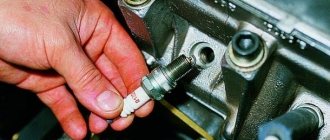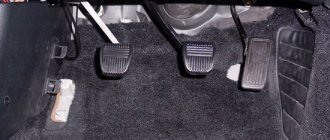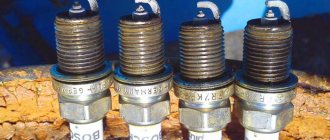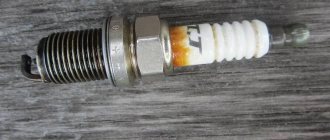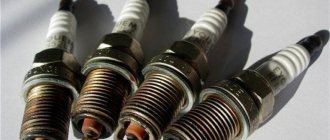The working part of the spark plugs is located directly in the combustion zone of the fuel mixture. Often, a part can serve as an indicator of the processes that take place inside the cylinders. By the amount of carbon deposited on the electrode, you can determine what is wrong with the engine. Black carbon deposits indicate a rich fuel mixture. Almost all drivers know this. But white spark plugs raise a lot of questions among motorists. Let's look at the main causes of white carbon deposits and ways to solve this problem.
What color of soot can be considered normal?
The fact that the engine is operating normally is indicated by an electrode with a light brown coating. In this case, there should be no soot or oil deposits on the electrode. This picture can be observed in new engines, as well as engines after major overhauls.
If the working part of the spark plug has a different color, then it is better to diagnose the engine and find the cause of the malfunction. However, the problem does not always lie in the motor itself. As for the colors of soot, it can be black, brick or frankly red, light gray. White spark plugs are also available.
Other deposits and deposits
White plaque is not the only possible deviation from the normal state of the electrodes. To correctly assess risks, you need to know the meanings of other shades of deposits.
Black
The following problems can cause the appearance of black soot:
- Over-enriched mixture, fuel sensor problems (dry residue remains on the electrode).
- Unsuitable “cold” candles.
- Air filter clogged.
- Oil combustion (shiny, sooty electrode and thread).
- Loose nozzle fit or broken check valve.
With late ignition and a small advance angle, the spark plugs turn black even with the correct choice of heat rating and gasoline.
Red and brown
Scarlet, brown and red soot is a consequence of the use of low-quality fuel with ferrocene, manganese or lead additives. A thick red layer can make it difficult for a spark to pass through and disrupt the operation of the engine, so when it appears, it is recommended to change the brand of oil or gas station.
Zolny
Ash soot can be both light and dark. When it appears, increased oil consumption, decreased power, and darkening of the exhaust gases are observed.
The cause of the problem is worn or stuck piston rings.
Erosion
If the spark plug is defective, early ignition, or prolonged operation on low-octane or low-quality fuel, erosion (destruction) of the central electrode may occur. At the same time, the power of the internal combustion engine decreases, and when driving, jerking, instability at idle and “triple” are observed. The part requires immediate replacement.
Gasoline on spark plugs
Filling of spark plugs occurs when there is a malfunction of the fuel system, injector or carburetor, less often when starting in cold weather. To solve the problem, you need a complete diagnosis of the car and repair of damaged parts of the internal combustion engine.
Oil and fuel deposits
A shiny yellow or dark coating indicates grease penetration and wear of the valve seals. A characteristic accompanying symptom is blue smoke and high engine oil consumption.
Fuel carbon deposits occur when valves become depressurized or the piston system wears out. At the same time, against the backdrop of a drop in power and unstable operation of the internal combustion engine, gasoline consumption increases.
In more rare cases, a green coating is observed on the electrodes. Its cause may be the presence of additives in gasoline or the ingress of antifreeze into the combustion chamber.
The main reason for the raid
The first thing to consider is that the spark plug is necessary to ignite the mixture of fuel and air. The spark plug inside the cylinder operates under extreme loads in difficult conditions, where various chemical and biological effects are provided - this is the high temperature of the spark and processes during combustion of the mixture.
The main reason for the formation of soot is the chemical reaction resulting from the combustion of the fuel mixture. The reaction leads to consequences such as high temperatures and the formation of decomposition products. After each combustion of the next portion of the fuel mixture, a small amount of deposits settles on the electrodes of the spark plug and the cylinder walls.
How to remove white residue from spark plugs
Spark plugs are consumables, just like filters, pads or oil. We do not recommend cleaning them. This is usually a waste of time and money. In addition, the use of faulty spark plugs can lead to failure of the ignition coil.
Remember that spark plugs should be cleaned after you have fixed the problem that caused the carbon deposits. There are several ways to remove plaque from a candle.
Chemical cleaning
We will need an old toothbrush, a small container and one of the following:
- Stove cleaner - Sanita and analogues.
- Dimexide from the pharmacy.
- Cleaning agent for plaque and rust - Cillit and analogues.
Pour the cleaning agent into a container, place candles in it and wait until the carbon deposits begin to dissolve. This usually takes 30-60 minutes.
After that, take a toothbrush and clean each candle. After cleaning, the candles should be rinsed, wiped with a dry cloth and dried.
Sandblasting
This method will require a sandblaster to clean the spark plugs.
The candle is screwed into the stand, compressed air is supplied and the spark is cleaned of carbon deposits using sand.
This method has no disadvantages, except one. Sand gets clogged between the body and the spark plug insulator. And it is no longer possible to get the grains of sand out of there.
To eliminate this drawback, there is an option to use soluble soda instead of sand. Or you can cover the gap around the insulator with a small piece of fabric.
Instead of a sandblasting stand, you can use a regular drill with reverse and a container of sand.
Cleaning spark plugs with a gas burner
For this method we need a portable gas burner. The candle must be fixed and heated with a burner flame until all the plaque burns out.
Causes of white soot
If there is a white coating on the spark plugs, experienced car enthusiasts will immediately identify the problem. This is a lean fuel mixture - relevant for both injection and carburetor engines. But there are other reasons. This is late ignition, as well as incorrectly selected spark plugs for a particular engine. To find the exact cause of such a malfunction, it is necessary to carry out a step-by-step diagnosis of the car.
When to contact a specialist
If you need to understand what kind of malfunction has occurred in the engine, then the best diagnostic tool will be spark plugs, since the ignition cycle of the working mixture is associated with them
White coating with a metallic sheen is very dangerous for the engine. Operating the internal combustion engine in constant overheating mode can lead to valve burnout and engine failure.
You should contact a specialist if:
- the engine began to idle unstably;
- the car began to jerk and the traction characteristics deteriorated;
- The coolant temperature quickly rises to its maximum level.
Ignoring the problem can lead to large financial costs for car repairs.
Lean mixture
The mixture of fuel and air must be correct - only then the engine will work perfectly. But this is not always the case. Even modern fuel injection systems, which are completely electronically controlled, sometimes fail.
If there is a white coating on the spark plugs, then there is more air in the fuel mixture than necessary. It is necessary to find the cause of the lean mixture. Often such a malfunction is associated with the leakage of foreign air into the system, as well as poor operation of the fuel pump. In addition, the engine may become leaner due to various malfunctions with the air flow meter and other sensors.
In the case of a carburetor, the fuel jets of the main metering system or the idle system may be clogged. Often a lean mixture is caused by too low a gasoline level in the float chamber. Often the malfunction is associated with clogged fuel filters or the fuel intake in the tank. This is why the spark plugs on the carburetor are white - in most cases it is because the fuel mixture is lean.
To normalize the situation, you need to find and eliminate the malfunction, then drive a set of spark plugs for some time, and after a while unscrew them and look at the condition.
Light electrodes
White or light gray spark plugs in all cylinders are a sign of a lean air-fuel mixture supplied by the injector or carburetor. Moreover, the skirt, area near the electrodes and the threaded part are absolutely dry, without traces of oil.
Why is the fuel mixture supplied lean?
- lambda - the probe incorrectly informs the control unit about the amount of oxygen in the exhaust gases, the reason is sensor wear;
- faulty or clogged nozzles;
- incorrect carburetor settings or clogged fuel jets;
- insufficient pressure in the injector fuel rail;
- problems with the idle air control;
- air leakage under the manifold or in another place;
- unsuccessful chip tuning of the controller made by the owner of the car.
A lean mixture does not pose any particular danger to a running engine, but it does cause discomfort to the driver. The car accelerates slowly, pulls poorly and jerks - there is a lack of fuel. Oddly enough, the phenomenon causes increased gasoline consumption - a car enthusiast who wants to achieve better performance indicators presses the accelerator pedal harder and more often.
Note. Often the light shade of the working electrodes is explained by the type of fuel used. If the car is operated on methane or liquefied gas (propane-butane mixture), this color is considered normal.
Incorrect fuel mixture adjustment
This is one of the reasons for a lean mixture. Often even on injection engines there is the possibility of adjustment. For example, in order to save fuel, drivers change the throttle opening angle by changing the position of the locking rings, displacing it in the grooves of the throttle needle. But such mythical savings can lead to disastrous consequences. Driving with a lean mixture, as indicated by white carbon deposits on the spark plugs, may be the cause of valve burnout.
You can make changes to the firmware of the control unit. There are a lot of software and hardware tools for this. Adjustments to the fuel mixture are made to increase engine power.
Injectors and fuel filters
This is a common reason for white spark plugs on injection engines. The needle and nozzle of this element are very thin, however, due to poor quality fuel or a clogged filter, various deposits form on the walls of the injector over time. The diameter of the passage hole, which is already very small, is further reduced. All this provokes a lean mixture.
In this case, the best and most effective solution is to regularly replace fuel filters - both fine and coarse. Cleaning and purging the injectors on special stands can also help.
Other deposits on the surface of the spark plugs
In addition to the appearance of contaminants, other residues of working fluids may appear on the SZ: for example, an oil solution. In this case, malfunctions also occur when starting the car: the engine stalls after a long period of inactivity, blue-white smoke flies out of the exhaust when you first try to start it, and the level of lubricant on the dipstick decreases significantly. The malfunction may be due to broken valve caps or removable rings on the pistons themselves.
There may be traces of gasoline and coolant. In the first case, this happens due to long and unsuccessful attempts to start the car, and in the second, the working fluid, antifreeze, gets into the internal combustion chamber. To fix the problem, you need to check the cylinder head gasket. The destruction of the spark plug can be caused by a low octane number, too early ignition or problems with the spark plugs. Also, a long trip on a detonating engine plays a role. To completely eliminate the problem, it is recommended to undergo electronic diagnostics at equipped stations.
Air leak
A lean mixture can also form due to the leakage of foreign air. If you cannot find the cause of the white spark plugs, and all checks have shown that the components and elements are in good condition, then it is recommended to carefully inspect each hose and pipe leading from the air filter to the intake manifold. It is also necessary not to forget that depressurization of the intake manifold itself is possible. Cracks can often form in an aluminum part. Replacement will be expensive, but will help get rid of white carbon deposits on the spark plugs and a lean mixture.
In addition, there may be air leaks where the idle speed sensor is installed. Experts recommend carefully checking the rubber seals that seal the connection.
Other signs of trouble
The following symptoms, which you can identify after unscrewing the spark plugs, will tell you about future and current problems with the engine:
- Motor oil can be seen on the threaded tip and area near the outer electrode.
- The working part protruding into the combustion chamber is covered with fluffy brown soot.
- The candle is frankly wet, and there is a strong smell of gasoline.
- The internal electrode is burnt or missing.
When there is a small amount of liquid oil on the spark plug, you should think about checking the cylinder-piston group . The lubricant penetrates through the oil scraper rings, entering the chamber with each cycle and upward movement of the piston, so it does not burn. As a rule, such an effect indicates the initial stage of wear of the compression and oil scraper rings.
The light brown color of the coating means that the engine consumes a large amount of lubricant due to waste. Moreover, the oil penetrates along with the combustible mixture through the opening valves. The fact is confirmed by the fact that the lubricant completely burns out and is deposited on the walls, since it enters the chamber only during the intake cycle. The reason is critical wear of the oil seals (otherwise known as valve seals). An additional sign is high oil consumption, amounting to 0.5–1 liters per 1 thousand kilometers.
A wet spark plug that smells of gasoline was probably unscrewed from a non-functioning cylinder. The second option is complete failure of the spark plug itself. Gasoline is regularly supplied into the chamber by an injector, but does not ignite and partially flows into the crankcase. If there is no compression in the cylinder, then compression and subsequent flash do not occur - fuel is wasted (consumption reaches + 25%) and dilutes the engine lubricant.
Reference. An idle cylinder is clearly audible at any engine speed - the engine desperately “troubles” and has difficulty starting when cold.
Obviously, a spark plug with a burnt-out electrode must be replaced. An important nuance: these parts are not replaced one at a time, but only in sets of 4 pieces. It is allowed to place a working spark plug in the cylinder temporarily - to get to the garage or service station.
Sooner or later, any driver begins to wonder whether the engine of his “iron horse” is working well. A visit to a service center, where it is possible to diagnose the engine using computer programs, or measure the compression level, can help to understand this situation, but both of these methods, like other technologies in this area, require sophisticated equipment and a good specialist. Naturally, this work is usually quite expensive. In order to avoid unnecessary expenses, you can first try to check the operation of the motor yourself. A careful inspection of the spark plugs will help us with this, namely the carbon deposits on them that have formed during the use of the car.
Soot on spark plugs will help an experienced motorist quite clearly determine what is wrong with the operation of his car. Low-quality fuel, interruptions in carburetor operation, disturbances in the cylinder-piston system, and many other problems will leave their mark on the ignition elements. To notice violations, the car owner will only need to conduct a careful inspection of the engine protection system and assess the state of the engine’s functioning by the color of the soot.
Late ignition
The mixture of fuel and air on which an internal combustion engine operates may ignite later than necessary. In this case, it burns out during the working stroke of the piston. This simultaneously causes the spark plugs to burn out and the engine to overheat. Late ignition can cause a white coating on the spark plugs.
On old simple carburetor engines, you can adjust the advance angle yourself using a strobe light. But this is difficult to do on engines with high mileage. In this case, the ignition should be set experimentally, since the strobe does not take into account the wear of individual engine elements.
There is no way to change the OZ in injection engines with your own hands - it is rigidly set in the firmware of the control unit. Here it is necessary to check the sensors responsible for the ignition timing one by one and replace those that are faulty.
Incorrectly selected candles
Spark plugs are divided into “hot” and “cold”. Manufacturers recommend their own kits for each engine. Often, products that lie on the shelves of car dealerships may not correspond to the declared characteristics, but motorists buy and screw in such spark plugs.
White deposits indicate that the part is too “hot” for this motor. To fix this problem, you just need to purchase and install the right spark plugs. It is possible to determine that a part does not correspond to the heat rating not only by carbon deposits, but also by characteristic traces of overheating or melting of the side electrode.
Unfortunately, there are currently no generally accepted standards for heat rating labeling. Therefore, you should select the most suitable spark plugs for engines of a particular model only from catalogs.
But a white coating on HBO spark plugs is considered normal. But it’s still better to purchase special gas parts, check the quality of the mixture and make sure that the proportions are normal.
Origin of red plaque
This phenomenon is less common than the effects described above. Why are there red electrodes on some spark plugs?
- the tank is filled with low quality gasoline with additives that increase the octane number;
- a car enthusiast or a fuel supplier adds additives to gasoline, which contain a large amount of metals;
- the owner of the car installed spark plugs in the cylinders that did not match the heat rating.
The reasons for the reddish tint of spark plugs do not pose a direct threat to the power unit, but are harmful in the long term. Driving on low-quality gasoline with unknown additives a priori accelerates the wear of parts and components. Plus an increase in consumption arising from worsening combustion conditions of the mixture in the cylinders.
How to properly service?
It is usually customary to change spark plugs that have traveled 30-40 thousand kilometers. But few people know that candles need to be maintained. Even with a fully functional ignition system, they may not work correctly. Various deposits and oxides can form on the electrodes, which interfere with the formation of a normal spark. As the metal burns out, the gap between the electrodes increases, which also complicates the spark formation process.
To extend the life of the spark plugs, they can be cleaned. But if you just clean the white spark plugs, the effect may not be due to the increased gap between the working parts. It is necessary to restore the normal gap. Then the ignition system will work perfectly.
The working part is covered with black soot
Black spark plugs are a symptom indicating that the fuel mixture is too rich (the proportion of gasoline is increased above normal). Therefore, the fuel does not burn completely and forms a layer of soot on the chamber walls and spark plug electrodes.
An additional sign of this problem is black or dark gray smoke from the exhaust. When over-gassing, small flakes of soot may fly out of the pipe.
There are quite a few reasons for the enrichment of the air-fuel mixture, the most common ones look like this:
- One of the key sensors has become unusable - air flow, temperature, throttle position or oxygen content in the exhaust (lambda probe). The controller activates the emergency program and prepares the mixture according to other indications.
- Carburetor malfunctions (clogged air jets, worn throttle valves, etc.).
- Failure of the pressure regulator in the fuel line.
- Wear of nozzles - nozzles “overflow” and leak when the power unit is not working.
- Problems with sparking - the power of the electrical pulse is not enough to ignite the combustible mixture normally.
Important! If during the diagnostic process you find black spark plugs, the fault should be found immediately. Increased gasoline consumption is only part of the consequences of excessive enrichment.
There are others, not so harmless:
- some of the unburned fuel penetrates the crankcase and dilutes the oil, accelerating the wear of engine parts;
- the other part gets into the exhaust manifold, which is why shots are periodically heard in it;
- soot clogs the expensive catalytic converter - it has to be cleaned or replaced with a new one;
- The service life of the spark plugs is sharply reduced.
When running on a rich fuel mixture, the engine “chokes”, unstable idling and skipped cycles are observed. When a certain amount of soot heated to a high temperature accumulates in the chambers, a “pseudo-diesel” effect occurs - after turning off the ignition, the engine does not want to stall and makes 2-10 crankshaft revolutions. The reason is hot soot, igniting the combustible mixture without a spark.
Other colors
We learned what white carbon on spark plugs means. But there are other shades that can also tell a lot.
For example, black candles. Black soot can have a different structure. And it’s one thing if it’s just dry deposits in the form of soot. The main reason is an over-enriched mixture. An oily coating indicates that a lot of oil gets into the cylinders and it does not burn completely. Also, black spark plugs will be on engines that have large oil appetites.
You can also see red soot. But he does not talk about any malfunctions. But it only indicates that the fuel used to fill the car contains certain additives. Experienced motorists and repair specialists cannot name other reasons for the appearance of a red coating.
Red tint of soot
A red coating appears when the car owner uses additives for working flammable fluids. The process is characterized by the burnout of chemical impurities that are poured in large quantities. If, with constant use, the prerequisites for the formation of red accumulations appear, it is recommended to reduce additives to a minimum. This malfunction is often observed where there are impurities of chemical elements. If you do not react in a timely manner to the appearance of a coating of this color, you can allow the appearance of a serious layer of waste fluids, which can lead to expensive car repairs - a spark will not appear when starting the car. Thus, the motor will work unstably. If the problem has already appeared, you need to carefully remove the deposits, completely change the flammable liquid (drain) and switch to a different brand of gasoline.
